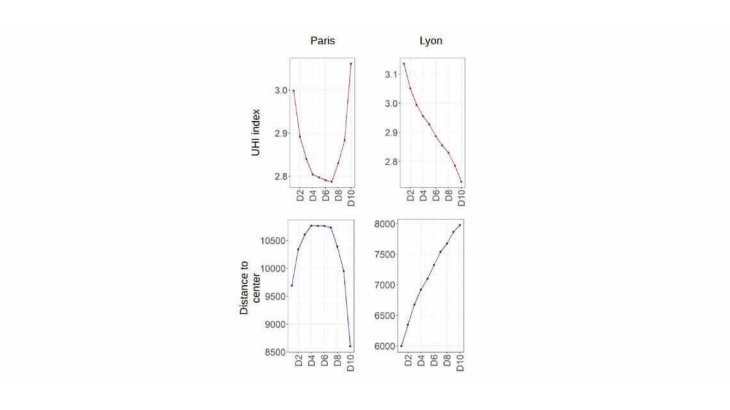Urban heat islands, a major challenge for cities
As the effects of global warming intensify, cities, where nearly 70% of humanity is expected to live by 2050, face a major challenge. Climate change leads to an increase in the frequency, intensity and duration of heatwaves, even in temperate climate countries. Heatwaves once considered exceptional, such as the 2003 event in France, could become the new norm by the end of the century and occur during a larger part of summer. Urban environments exacerbate the effects of heatwaves, creating urban heat islands (UHIs) (IPCC, 2023). Urban concentration leads to higher temperatures, especially at night because conventional building materials, roads, and infrastructure absorb and retain heat. UHIs are also amplified by the lack of vegetation and by the heat generated by human activities (engines, air conditioning) (EPA, 2023).
Extreme temperatures can be a direct cause of death though heat stroke, hyperthermia, or dehydration. Some populations are particularly vulnerable, such as the elderly and young children, but this can also be the case for low-income people, because, on average, their health may be more fragile than the population as a whole. In addition, low-income populations cannot afford to leave cities during heatwaves, for example to go to rentals or second homes, as wealthier households are able to do. They are forced to stay at home with poor insulation, and have little over the temperature because they lack the means to cool their homes with air conditioning.
A first analysis of climate inequality with respect to UHI in France
Our recent study, an INSEE-Banque de France working paper, presents the first analysis of climate inequality with respect to UHIs in France. We measure UHI exposure among households by income in the major French cities. To do so, we produce unique highly granular databases by compiling and matching finely localised data on temperature, vegetation, residential building density, height and period of construction, and households’ socioeconomic characteristics across nine of the largest French cities.
We find that the relationship between UHI exposure and income in a given city depends on households spatial sorting by income (Chart 1). In Paris, Bordeaux, Lille, and Nantes, high- and low-income households live closer to the city centre than median-income households, and UHI exposure follows a U-shape curve, particularly pronounced in Paris. In Lyon, Montpellier, Marseille, Nice, and Strasbourg, affluent households live in rich suburbs, and UHI exposure decreases with income. We also show that in all cities, except Paris for density, wealthier households live on average in greener, less dense neighbourhoods with lower buildings. In cities where wealthy households live close to the city centre, they also typically reside in older neighbourhoods. In contrast, in cities where they live further from the city centre, they tend to reside in newly established neighbourhoods.
The primary sources of this unequal exposure
To guide public policy interventions, we identify the primary sources of unequal exposure to UHI by income across cities and we quantify their contributions to the unequal exposure to UHIs by income deciles (see the INSEE Analyses based on our INSEE-Banque de France working paper). First, building density, then vegetation and building height contribute to a decreasing relationship of UHI exposure with income in all cities, except Paris for building density. As older housing is usually of lower quality, the date of construction of residential buildings at the neighbourhood level partly explains the varied U-shaped in the first group of cities and decreasing curves of UHI exposure by income in the second one.
Vulnerable households are more exposed
Some populations are particularly vulnerable during heatwaves, such as young children and the elderly. We find that households with at least one child under 10 or one elderly person over 65 are not more exposed to UHIs than others. However, this is no longer true when these households live below the poverty line. In all the cities studied, these particularly vulnerable households are exposed to slightly higher temperatures than other households.
Nevertheless, these small differences in exposure can be amplified, as low-income households are less able to mitigate the effects of UHIs. They are less likely to improve their home insulation as they are much less likely to own their homes, to escape the city during heatwaves as they rarely possess secondary dwellings, or to cool their homes with air conditioning.
Policy recommendations
At the city level, even when considering existing urban planning constraints, there are numerous feasible solutions for cooling cities and their effects would be cumulative. Nature can be reintegrated into urban areas by removing waterproofing from pavements, planting trees, greening floors, facades, roofs, or uncovering rivers. Buildings and urban planning also play crucial roles. Integrating summer comfort objectives into construction or renovation criteria, using light-colored cladding or white roofs to reflect heat, adapting to wind corridors, and building public fountains or shade houses can significantly mitigate the impact of heatwaves (Santamouris, 2007).
Our study shows that poor households are often the most exposed to UHI effects, living on average in less green, denser, and taller neighbourhoods. Measures implemented to locally reduce UHI effects should prioritise poor neighbourhoods to avoid exacerbating their relatively higher exposure. This precaution is crucial given the regressive impacts, both in terms of initial exposure and income, observed in pollution mitigation policies (Champalaune, 2020), or in urban greening policies.
At the household level, we discuss the practical feasibility of exposed households limiting their use of air conditioning, which exacerbates heat stress outdoors. Viguie et al. (2020) show that adaptation strategies (large scale urban greening, building insulation policy, generalised behavioural changes in air conditioning use) can reduce AC energy use by half during heatwaves.
